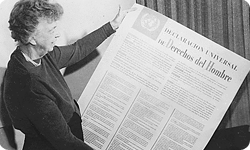Understanding and applying human rights
 Dr Diane Sisely
Dr Diane Sisely
December 10, 2008, marked the day 60 years ago when the world agreed on the principles and values necessary to safeguard if people are to be able to live a decent life, with dignity and respect.
The document agreed, the Universal Declaration of Human Rights, has perhaps never been more important than it is today, as it provides us with the guiding principles for the work required to counter the challenges of the economic crisis and climate change so that our children’s children can also lead a decent life, one with dignity and respect.
In this country we have a strong belief in the idea of ‘a fair go’. When asked, we can usually explain what it involves. For example, we are likely to say that it involves equal opportunity, giving someone ‘a hand’ when she or he is facing hard times, concern for the ‘underdog’, ‘one vote, one value’ and generosity to strangers, albeit sometimes qualified generosity and only after we have got to know people as individuals.
However, we are not so sure about human rights and how to describe them. We perhaps understand when the rights of people in Sudan or Guantanamo Bay are being abused and when the rights of people in countries in political turmoil are at risk, such as in Sri Lanka, but when it comes to ourselves we are often unsure. We don’t understand and are sometimes a little suspicious of the legal terminology surrounding human rights. But put simply, human rights are about the basic values we share and wish to live by, the very same values that underlie a ‘fair go’.
In Victoria the Charter of Human Rights and Responsibilities has been in full effect since the start of 2008. It puts human rights at the very heart of Victorian Government policy and service delivery, it protects our rights and it seeks to ensure we are able to live decent lives. Lives that are free from fear, so we are not, for example, reluctant to enter public spaces, such as public parks or pubs, for fear of harassment. Lives where we have a fair chance of achieving success, so we can take full advantage of our educational system and not be denied by subtle prejudice or ignorance.
It also means that those who provide government services must do so in a way that protects our rights. Hospitals, schools, local councils, the police, universities, even private contractors providing services to government, need to comply, meaning this is a legal obligation that will touch the lives of millions.
The Australian Centre for Human Rights Education (ACHRE) at RMIT University has developed two exciting postgraduate programs which explore what it means and what it takes to build a culture and practice of human rights. Relying on the law is not enough.
By studying the Graduate Diploma or Graduate Certificate of Applied Human Rights, you can learn how to apply human rights in your workplace, organisation or life. ‘Introduction to Applied Human Rights’ lets you discover how human rights are applied in different situations and through ‘Transforming Organisations and Applied Human Rights’ you get to learn how you can make your workplace or organisation a better place. ‘Applied Human Rights and Indigenous Peoples’ is a way to start to focus on issues facing indigenous peoples, with their involvement.
In ‘Education for Human Rights’ you learn to teach and train for human rights and the ‘Ethics and Practice of Human Rights’ become apparent through this course. ‘Advocacy and Action: The Victorian Charter of Human Rights’ is the cornerstone of applying human rights and, through learning the means and methods of communication, you learn about ‘Human Rights as Applied Communication’, and in the ‘Human Rights Campaign Studio’ you get to work on a real-life human rights campaign.
These courses provide students with an understanding of how the Charter plays a role in their lives and how it can play a role in their workplace or home. To find out more go to www.rmit.edu.au/achre. Applications are now open for July commencement.
Dr Diane Sisely is a Liberty Victoria committee member and director of the Australian Centre for Human Rights Education.
